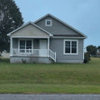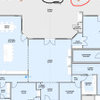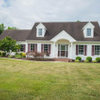Ipe and ATO
I read a lot of posts on finishes for Ipe and I have settled on ATO. I installed a new ipe deck in September, waited 2 months for weathering, and then did a light sanding with 50 grit (mistake #1) and wiped lapachol up with mineral spirits. Let dry and applied ATO with brush, and wiped off excess. Looked great
After about 8 weeks, I noticed some mildew spots in one corner ... and over the winter they grew. One toprail was almost black by spring.
The problem was my environment here on the beach, and the overnight dew. I never noticed the heavy dew (mistake #2) until got up early one morning and caught the drip drip drip from the corner of the eave, onto the top rail that was splashing onto the corner of the deck. Even though the deck got direct sun for the second half of the day, the early-morning dew was enough to keep mildew happy in one corner. Plus the color was rapidly fading from the ATO application. (Having sanded before application, I got very poor penetration)
It turns out because this deck is somewhat shielded from the prevailing winds, I get a heavy dew on this side of the house 5 out of 7 nights almost year-round... and I did not cover the deck with plastic overnight before the original ATO application (mistake #3).
I conceded that was going to have to strip the deck. So I decided to try some different ideas on some ipe scrap before stripping and refinishing the deck in the spring. Being an engineer that worked for a large paper pulp mill for almost 20 years, I had some ideas.
The pigments will never be taken very deep into the wood. The resins will penetrate a little, but not much. The oils penetrate the farthest. As many have posted here, the natural oils in the ipe, and its density make deep penetration impossible. Sanding a dense wood like ipe does not open up the pores to any appreciable degree.... instead it has a greater affect on penetration by reducing surface area.
What was needed was a strong base like NaOH to break down the lignin and mechanical abrasion to increase the surface area, and open up the wood to a greater degree. What I wanted was to open up the wood and also increase surface area. Normally increasing surface area means more surface area for water absorption into the wood (bad) but with ipe, it’s density and natural oils make that irrelevant. I believe the greater surface area would benefit the ATO penetration.
If you have mildew, you have water, and unless you stop the water, nothing you will do will stop the mildew.
Step 1: Install drip guard on roof to prevent dew from dripping onto deck and toprail.
Step 2: Chlorine bleach to kill off the surface mildew so it doesn’t get spread around to other parts of the deck. Spray application. Lightly scrub and rinse well.
Step 3: Commercial Sodium metasilicate cleaner to clean the worst stains. Spray application. Heavy scrub and rinse well.
Step 4: NaOH caustic solution and a very stiff, coarse, plastic-bristle brush. Let the caustic sit a few minutes and brush HARD parallel into the grain. Wore my shoulders out pushing that brush, but as I pushed, I built up little mounds of light yellow wood pulp. About a tablespoon of pulp for each 10 linear foot of 1x6. After a good rinse, I could feel a slight texture to the surface. Not grain, but a “soft” feel.
Step 5: Second (weaker) chlorine bleach treatment to kill remaining mildew and any mildew brought onto the deck by foot traffic. Heavy scrub and rinse well.
Step 6: Oxalic Acid neutralizing wash. Spray application. Lightly brushing, let sit for 30 min, and rinse well.
At the end of the day, I covered the deck with 4-mil plastic... no dew will reach the deck THIS time.
Now I an waiting 3 days to apply the ATO.... but I have to chose which application method.
The samples I did over the last few months have confirmed for me that the NaOH stiff brushing to slightly roughen the surface gets the best ATO penetration. Sprayed on and brushed out evenly, there is _no_ ATO left to wipe back up! A couple of tack spots is all, and they are gone in 2 -3 days. The samples done this way also have the greatest abrasion test performance.... (a weighted sandpaper rub with 50 pulls.)
I also had good results with hand-rubbing additional coats of ATO. I covered samples overnight with plastic for 3 days to ensure no dew water, and instead of brushing the ATO on, I applied it as a rub with a cotton sock. Dip, and rub in. Leaving much less on the wood than would be left with a brush.... much like the process for staining a softwood. The second application kept its color and resistance to water much longer.... by the 4th coat, I am getting long-term resistance to rings from water spots. The water still beads after 4 months. And it looks fabulous.
My question is: does anyone have any experience or comments on applying additional hand-rubbed coats of ATO on top of a brushed on base coat, with about 4 weeks of weathering between coats?







diemond
Related Discussions
ipe / ato scratches when moving items on deck
Q
cabot ato mahogany flame changed!
Q
Australian Timber Oil/ Mold
Q
twp trumps ato -- but which twp?
Q